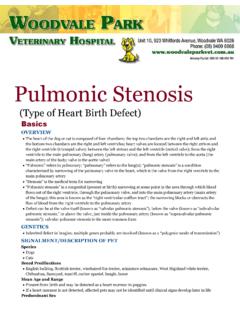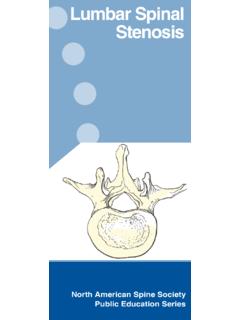Transcription of Cervical Stenosis with Myelopathy - Midwest SpineCare
1 Cervical Stenosis with Myelopathy Cervical Stenosis pinches the spinal cord As we age, the spine may develop degenerative changes in the joints that can create tightening of the spinal canal. Over time this process may lead to pinching the spinal cord and compromise of coordination of the extremities. Symptoms of Cervical Stenosis with Myelopathy People with this condition may note one or more of the following symptoms: Heavy feeling in the legs Inability to walk at a brisk pace Deterioration in fine motor skills (such as handwriting or buttoning a shirt) Intermittent shooting pains into the arms and legs (like an electrical shock), especially when bending their head forward (known as Lermitte s phenomenon) Arm pain ( radiculopathy) Often it is the arm pain that prompts someone with this condition to seek medical treatment, and then the Myelopathy is discovered through medical history and physical exam.
2 Cervical Stenosis with Myelopathy affects the nerves Myelopathy affects the nerve tracts that run inside the spinal cord (long tracts) and deficits in these long tracts can be picked up on physical exam. For example: Muscular tone in the legs will be increased, Deep tendon reflexes in the knee and ankle will be accentuated (hyperreflexia) Forced extension of the ankle may cause the foot to beat up and down rapidly (clonus) Scratching the sole of the foot may cause the big toe to go up (Babinski reflex) instead of down (normal reflex) Flicking the middle finger may cause the thumb and index finger to flex (Hoffman s reflex) Compromised coordination may be evidenced by difficulty walking placing one foot in front of the other (tandem walking) Diagnostic tests for Cervical Stenosis with Myelopathy An MRI scan and/or a CT with myelogram can show the tight canal and associated spinal cord pinching.
3 The condition may be present at one or several levels in the spine. Often, Cervical Stenosis with Myelopathy is associated with some degree of instability, and flexion/extension lateral Cervical spine x-rays are useful to rule out abnormal motion and instability. Somatosensory Evoked Potentials (SSEP), an electrical study, is done by stimulating the arms/legs and then reading the signal in the brain. A delay in the length of time that it takes to get to the brain indicates that there is a compromise of the spinal cord. Treatment for Cervical Stenosis with Myelopathy The only effective treatment for Myelopathy is surgical decompression of the spinal canal. If the patient also has a radiculopathy (myeloradiculopathy), conservative treatment may help relieve the arm pain. Myelopathy is a generally progressive condition that develops slowly. Symptoms may not progress for years, and then difficulties with coordination may suddenly increase.
4 Unfortunately, the symptoms rarely improve without spine surgery to decompress the affected area. Surgical decompression may or may not improve the symptoms. Typically, the main goal of the spine surgery is to arrest the progressive nature of the condition and stabilize the patient s neurological condition. Surgical decompression can be performed through an anterior (front) approach or posterior (back) approach. The type of approach is generally dependent on the surgeon s preference and where the majority of the compression is located (in the front or back). Often, multiple levels need to be decompressed, so the spine surgery tends to be more involved than that for disc herniations or foraminal Stenosis .




